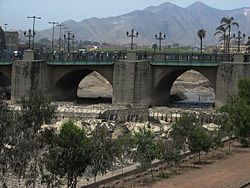Puente de Piedra
Puente de Piedra | |
|---|---|
 | |
| Coordinates | 12°02′36″S 77°01′47″W / 12.043357°S 77.02978°W |
| Heritage status | National and UNESCO World Heritage site (1988) |
| History | |
| Architect | Juan del Corral |
| Built | 1610 |
| Location | |
 | |
The Bridge of Stone (Spanish: Puente de Piedra) is a bridge in Lima, Peru. It was built in 1608 by the architect Juan del Corral to link Lima with Rímac.[1] It is the beginning of the jirón de la Unión, which was, in the first independent years of Peru, the most important road in the city. Until 1861, it was the only bridge in the city.
Name[edit]
The bridge is known by several names, including:
- Old Bridge (Spanish: Puente Antiguo)
- Trujillo Bridge (Spanish: Puente Trujillo): the name comes from the fact that the bridge is the extension of jirón Trujillo.
- Egg Bridge: this name comes from the stone masonry mortar which was believed to have been mixed with egg whites from sea birds to improve its consistency.[2]
History[edit]
The Stone Bridge replaced the bridge that the viceroy Andrés Hurtado de Mendoza had ordered to be built in the 16th century and that a flood of the Rímac river had destroyed in 1607.[3]
It was built in 1610 by the Spanish architect Juan del Corral, born in Santander, during the mandate of Viceroy Juan de Mendoza y Luna, Marquis of Montesclaros, before the progressive urbanization of the neighborhood "below the bridge" (current district of Rímac). It cost more than 400,000 pesos at that time.[3]
At the entrance to the bridge, on the Cercado side, the Gate of Lima was built, a stone and brick structure, which was damaged on several occasions due to several earthquakes. In 1738, a bronze statue of Felipe V, made by Baltazar Gavilán. This was destroyed in the 1746 earthquake and was replaced by a monumental clock, which was nevertheless destroyed in a fire in 1789.[3]
The bridge was the only link between the north bank of the bridge and the old walled city until the 19th century.[3]
In 1808 important repairs were carried out during the viceroyalty of Joaquín de la Pezuela. Until 1861, when the Balta Bridge was built, it was the only link between the old walled city and the north bank. In 1902 the bridge was widened and acquired its current form.[3]
With the construction of the Vía de Evitamiento, a public transport stop was established, which was transferred in 2006 after the construction of the Rayito de Sol Bridge. In 2010, it was lowered for the construction of the Vía Parque Rímac tunnel on the Yellow Line.
References[edit]
- ^ "Lima Peru Rimac, Plaza de Acho". Lima.info. Archived from the original on 28 January 2015. Retrieved 10 July 2014.
- ^ "Rimac". Go2Peru. Archived from the original on 2 December 2021. Retrieved 10 July 2014.
- ^ a b c d e Bromley Seminario, Juan (2019). Las viejas calles de Lima (PDF) (in Spanish). Lima: Metropolitan Municipality of Lima. pp. 60–61.


 French
French Deutsch
Deutsch